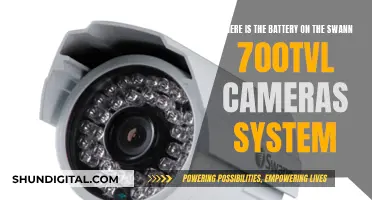
Dash cams have become increasingly common in cars, with some vehicles offering built-in cameras and others having them dealer-installed. They are used for a variety of reasons, including improving vehicle security, safety, and convenience, as well as enabling autonomous driving features. In-car cameras can also be used to combat drunk driving by monitoring the driver's face and behaviour. Additionally, some people use dash cams to record their surroundings while driving, which can be helpful in the event of an accident or for insurance purposes.
| Characteristics | Values |
|---|---|
| Improve safety | Reducing blind spots, improving vehicle security, and enabling autonomous driving |
| Enhance convenience | Providing a bird's-eye view of the vehicle's exterior, assisting with parking, and monitoring the driver's behaviour |
| Increase data collection | Capturing footage for insurance, mapping, and autonomous driving development |
| Combat drunk driving | Analysing the driver's face and behaviour to detect impairment |
What You'll Learn
- Dash cams can be used to improve vehicle security and safety
- Cameras can help cars see and move closer to an autonomous future
- They can be used to combat drunk driving by monitoring the driver's face and behaviour
- Footage can be used as evidence in a case concerning an impatient or impaired driver
- Some cameras can be used when the vehicle is turned off

Dash cams can be used to improve vehicle security and safety
Dash cams have become increasingly popular in recent years, with many drivers opting to install them in their vehicles. But why are people choosing to add this extra piece of technology to their cars? One of the main reasons is to improve vehicle security and safety.
Dash cams can provide valuable evidence in the event of an accident or road incident. They can capture footage of the moments leading up to a collision, which can help determine who was at fault and provide crucial details for insurance claims. This can be especially useful in hit-and-run cases, where the driver may not have been able to get the other vehicle's information. With a dash cam, drivers can have peace of mind knowing that they have a record of any incidents that occur on the road.
In addition to recording footage, some dash cams also offer advanced driver-assistance systems (ADAS). These systems use the camera's "eyes" to enable features such as lane-departure assist and forward-collision warning. By analysing the vehicle's surroundings, these systems can provide drivers with important alerts and even take corrective actions to avoid potential accidents. This not only improves the driver's safety but also that of other road users, including pedestrians and cyclists.
Furthermore, dash cams can also be used to monitor the driver's behaviour and help combat issues such as drunk driving. Cameras with facial recognition software can detect signs of impairment or distraction and intervene if necessary. This technology can not only improve road safety but also reduce risky behaviours and promote responsible driving.
While dash cams offer many benefits, it is important to consider privacy concerns. The footage captured by these cameras may contain sensitive information about individuals, such as their location or activities. Therefore, it is crucial for dash cam users to be mindful of the privacy laws and permissions regarding video recording in their respective states or countries.
Overall, dash cams can indeed be a valuable tool for improving vehicle security and safety. They can provide evidence in accidents, assist with advanced driver-assistance systems, and even help address issues like drunk driving. However, users must also be responsible for handling the captured footage with care and respect for others' privacy.
Troubleshooting Snapchat Camera Focus Issues
You may want to see also

Cameras can help cars see and move closer to an autonomous future
Cameras are an essential component of autonomous vehicles, acting as the eyes of the car and enabling it to sense and understand its surroundings. With advancements in camera technology, such as autofocus and high-resolution sensors, cars are getting closer to achieving true autonomy.
Enhancing Safety and Decision-Making
Autonomous vehicles rely on advanced sensing hardware, including cameras, to capture information about their surroundings. Cameras provide crucial data for decision-making and control processes, helping to identify obstacles, track moving objects, and maintain alertness in various environmental conditions. This technology aims to reduce the number of accidents caused by human error, such as misjudging speed or distance, or lacking absolute alertness.
Improving Object Recognition and Lane Keeping
Cameras play a vital role in object recognition, enabling autonomous vehicles to distinguish between pedestrians, traffic infrastructure, and road signs. They also assist in automatic lane keeping, especially in densely populated cities or poorly maintained roads. By using multiple cameras positioned around the vehicle, a 360-degree field of view can be achieved, enhancing the car's understanding of its environment.
Advancements in Camera Technology
Recent innovations, such as the Sharp-7 autofocus camera by Sheba Microsystems, have the potential to revolutionize autonomous driving. This camera utilizes MEMS actuators to produce high-quality, stable images across extreme temperatures and terrains. It enables precise object detection and differentiation, ensuring advanced driver-assistance systems operate with enhanced reliability and safety.
Pushing the Boundaries of Computer Vision
Companies like Tesla are at the forefront of the camera-only movement, utilizing neural networks and camera input to estimate depth, velocity, and acceleration. While some argue that multiple sensors are necessary for safe autonomous driving, Tesla demonstrates that deep learning and advanced image processing can overcome many of these challenges.
Moving Towards a Camera-Centric Future
As the automotive industry continues to evolve towards automation and connectivity, cameras will remain a fundamental component. The combination of computer vision and deep learning enables autonomous vehicles to recognize and interpret their surroundings, make critical decisions, and move towards a safer and more efficient future.
The Camera Obscura: Unveiling Its Intriguing Components
You may want to see also

They can be used to combat drunk driving by monitoring the driver's face and behaviour
In-car cameras are an increasingly popular feature in modern vehicles, and one of their key functions is to combat drunk driving by monitoring the driver's face and behaviour. This technology is being developed by several car manufacturers, including Volvo, Cadillac, and BMW, with the aim of improving road safety and reducing traffic fatalities.
Volvo, for example, has announced that it will be implementing in-car cameras across all its models, starting in the early 2020s, to monitor drivers for signs of intoxication and distraction. The system will warn drivers if they are deemed unfit to drive and, if they continue, the car will take control, slow down, and safely park. This initiative is part of Volvo's Vision 2020 plan, which aims for zero fatalities or serious injuries in their vehicles. According to Volvo, human behaviour, including speeding, intoxication, and distraction, is the most pressing safety issue currently faced by automakers.
Similarly, Cadillac offers an advanced driver assistance system called Super Cruise, which uses infrared cameras to track the driver's eye movements and enable hands-free driving. If the driver becomes distracted or inattentive, the system uses audible and vibrating alerts to ensure they keep their eyes on the road.
In-car cameras can also be used in conjunction with other technologies to combat drunk driving. For instance, apps like EnDUI, Breathometer, and Alcohoot help individuals calculate their blood alcohol content (BAC) and provide resources to find alternative transportation if they are over the legal limit.
While these in-car camera systems have raised concerns among privacy advocates, automakers emphasize that their primary goal is to improve safety and potentially save lives by reducing drunk driving incidents. The data collected by these cameras is typically used solely for safety purposes and requires user consent.
By monitoring the driver's face and behaviour, these in-car camera systems can identify signs of intoxication, such as drowsiness, erratic eye movements, or failure to keep hands on the steering wheel. This allows the system to intervene and prevent the driver from operating the vehicle while impaired, reducing the risk of accidents and making the roads safer for everyone.
Mastering Manual Focus on Your Mirrorless Camera
You may want to see also

Footage can be used as evidence in a case concerning an impatient or impaired driver
Dashcams have become increasingly common in modern cars, with some vehicles offering drivers the ability to record footage both inside and outside the car. This footage can be used as evidence in a case concerning an impatient or impaired driver.
In the event of an accident, a dashcam can automatically save a recording of the incident, providing valuable evidence for insurance claims or legal proceedings. For example, the BMW Drive Recorder saves footage from 20 seconds before to 20 seconds after an impact, while the Subaru EyeSight system records a 22-second loop of footage to help in the event of an accident.
Additionally, some dashcams allow drivers to manually activate the recording function, providing further flexibility in capturing evidence. The Mercedes-Benz Dashcam, for instance, can be activated at will by the driver and the footage can be easily downloaded to a smartphone or USB device for review.
The use of dashcams as evidence is particularly relevant in cases involving impatient or impaired drivers, as the footage can clearly show the actions and behaviours of the driver in question. This can include instances of aggressive driving, road rage, or impaired driving due to alcohol or drug influence.
Furthermore, dashcam footage can also help in identifying and prosecuting hit-and-run drivers, as well as providing evidence of the driver's condition or behaviour before, during, and after an accident. This can be crucial in determining liability and ensuring that unsafe drivers are held accountable for their actions.
Are 360-Degree Car Cameras Necessary for Road Safety?
You may want to see also

Some cameras can be used when the vehicle is turned off
Some car cameras can be used for surveillance when the vehicle is turned off. These cameras are designed with a 'parking mode' feature, which allows them to monitor and record activity around the car even when the ignition is off. This can be useful in the event of vandalism or a hit-and-run incident.
Dashcams with parking mode can detect motion or impact, and start recording accordingly. This ensures that your vehicle is protected at all times, even when you are not around.
To ensure continuous recording without draining your car battery, some dashcams come with power-saving features or support alternative power sources. For example, you could use an external battery pack or hardwire your dashcam directly to your car's electrical system.
It is important to note that not all dashcams are created equal, and some may drain your battery faster than others. When shopping for a dashcam, it is crucial to look for one with the parking mode feature if you want 24-hour surveillance.
Professional dashcams are a top-tier option, offering advanced features such as enhanced video resolution, wider viewing angles, and superior night vision capabilities. They also often come equipped with parking mode, so you can rest assured that your vehicle is being monitored even when the engine is off.
In summary, some car cameras can indeed be used when the vehicle is turned off, providing added security and peace of mind for car owners.
Rental Cars and Dash Cams: Who's Watching?
You may want to see also
Frequently asked questions
Cameras in cars can improve vehicle security, safety and convenience.
Cameras can be used to combat drunk driving by analysing the driver's face and behaviour.
Cameras can help with blind spots, and some cars have cameras that provide an enhanced bird's-eye view of the vehicle's exterior.
Some cameras can be used when the vehicle is turned off, for example, to alert owners that someone might be tampering with their parked car.
Car cameras can be used to collect data about driving habits, which can be used for future innovations like digital road maps that can help with autonomous driving.







